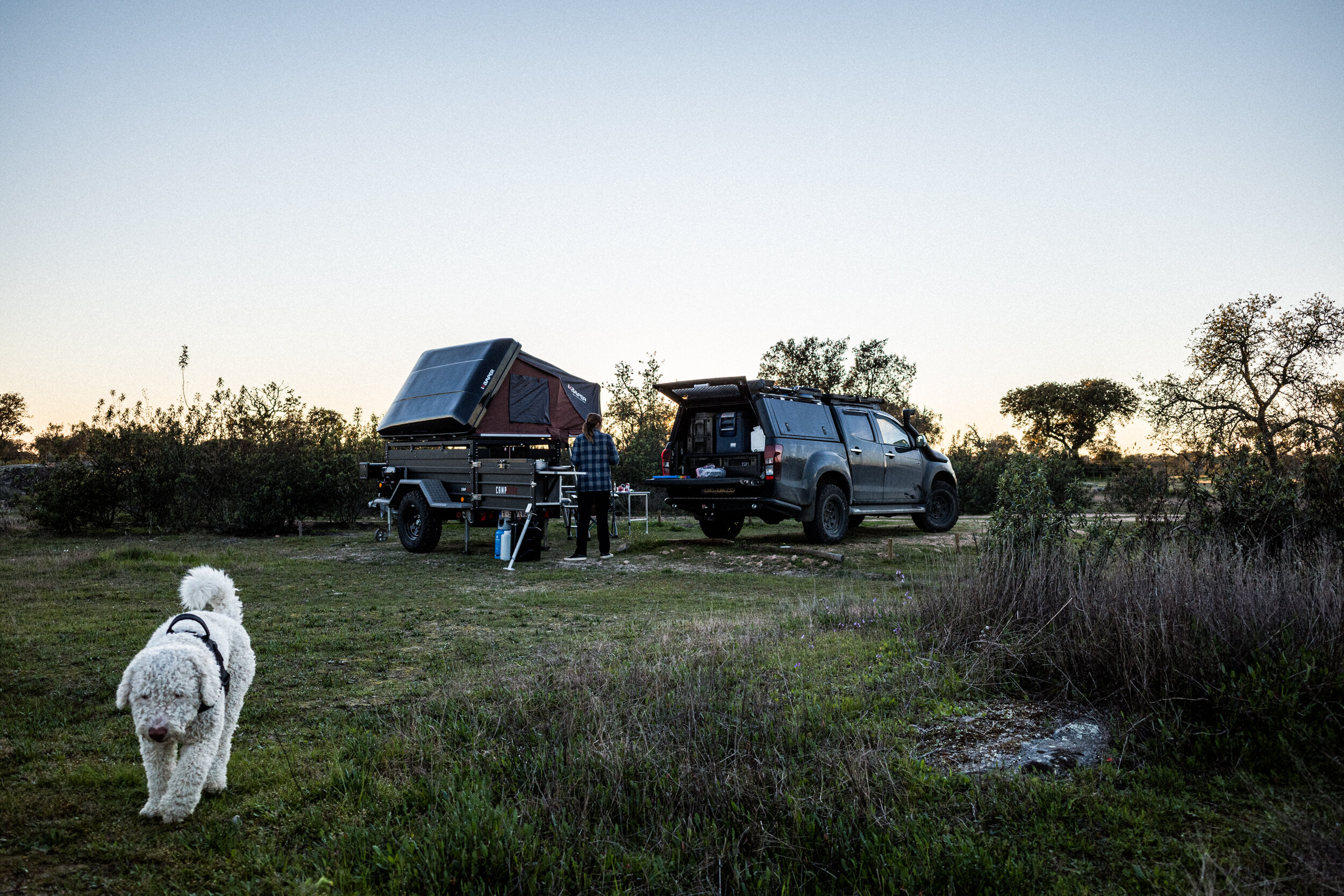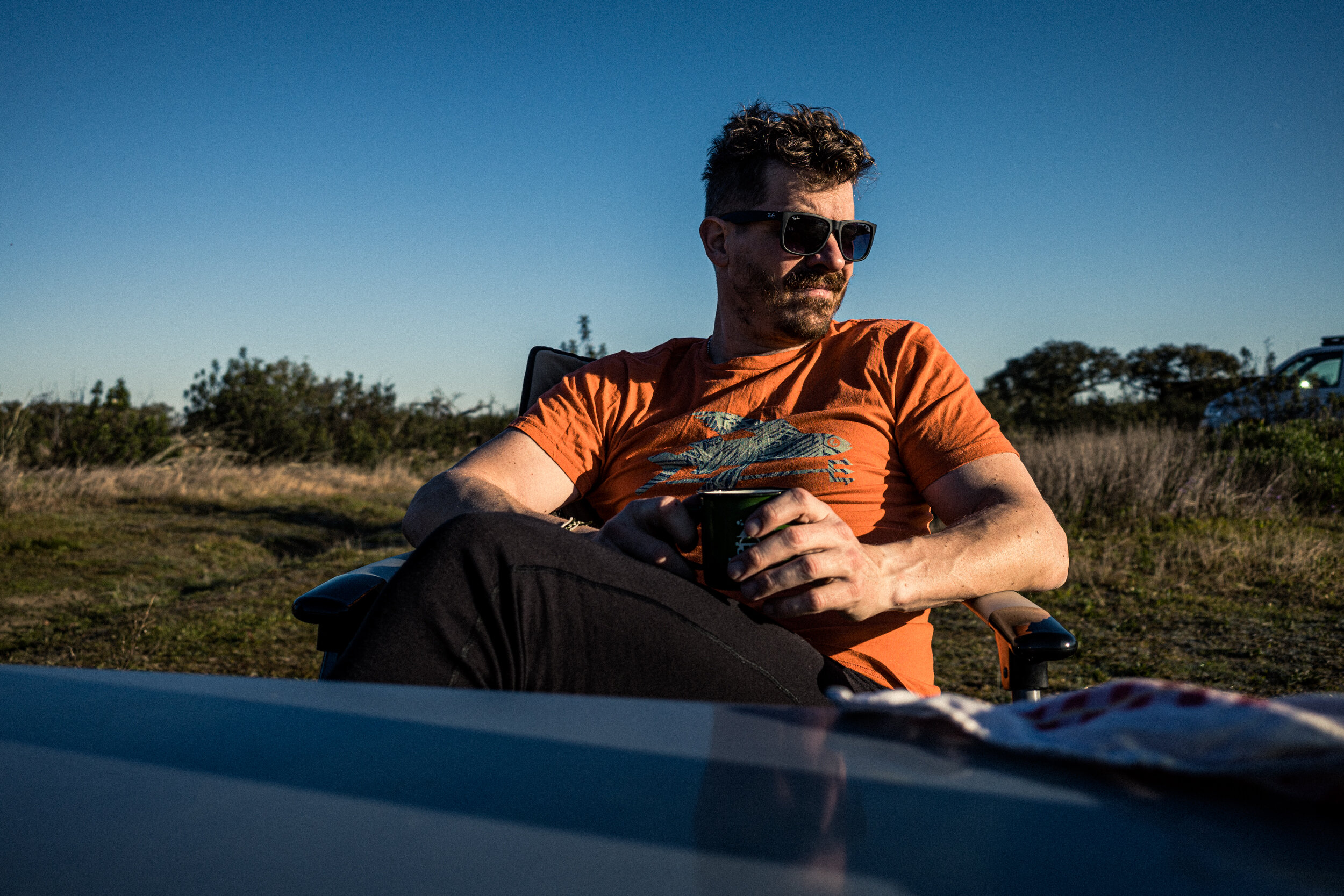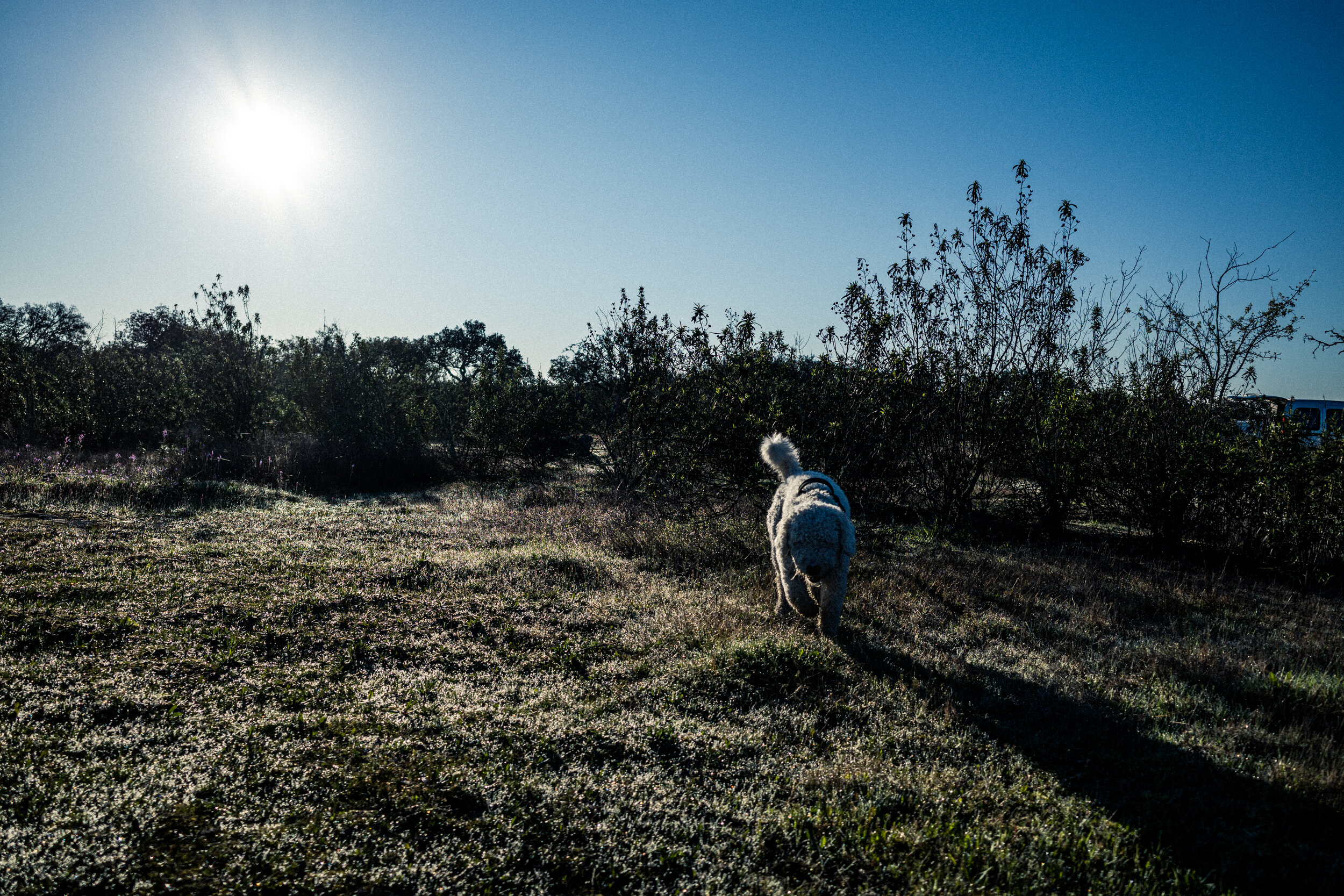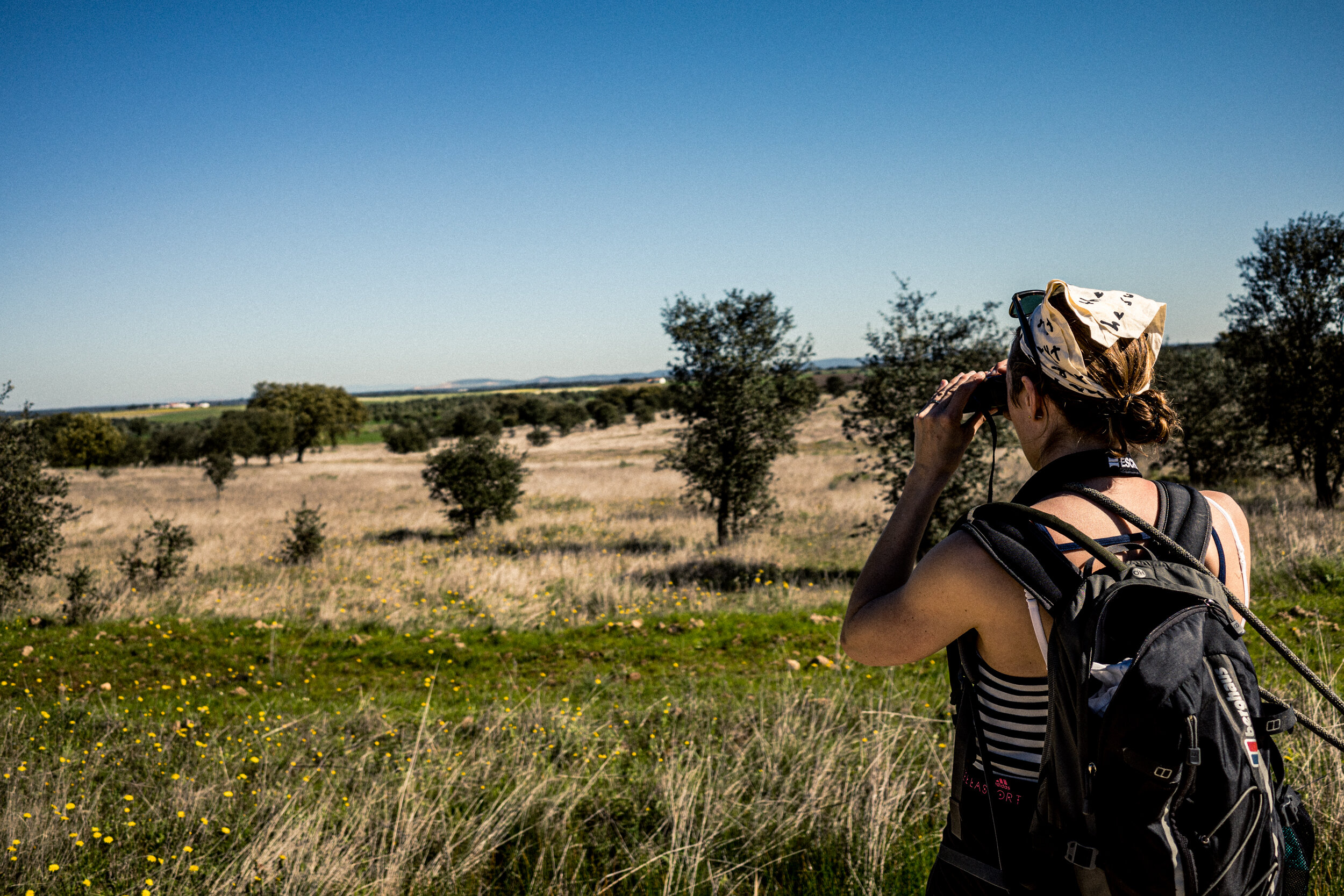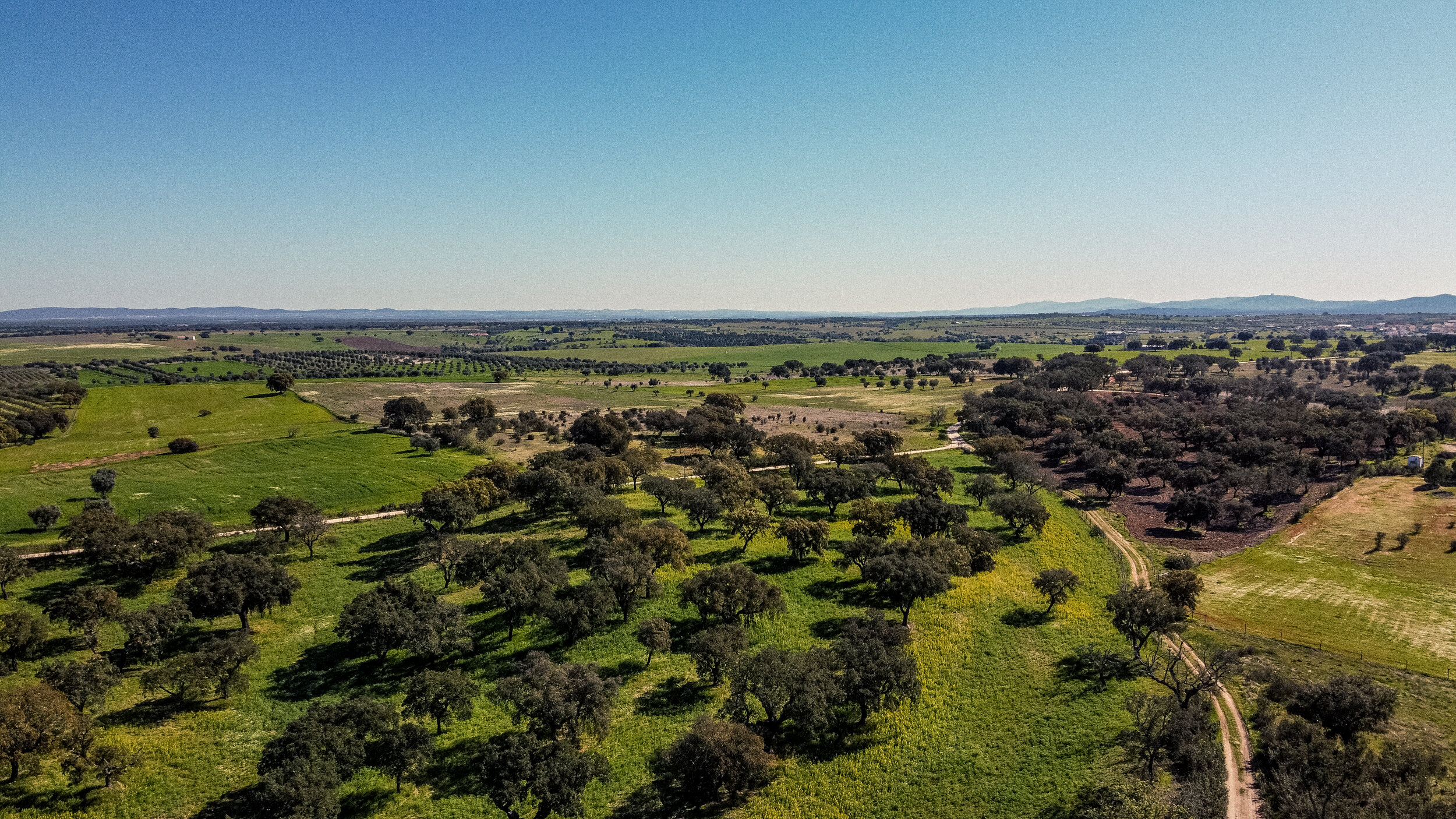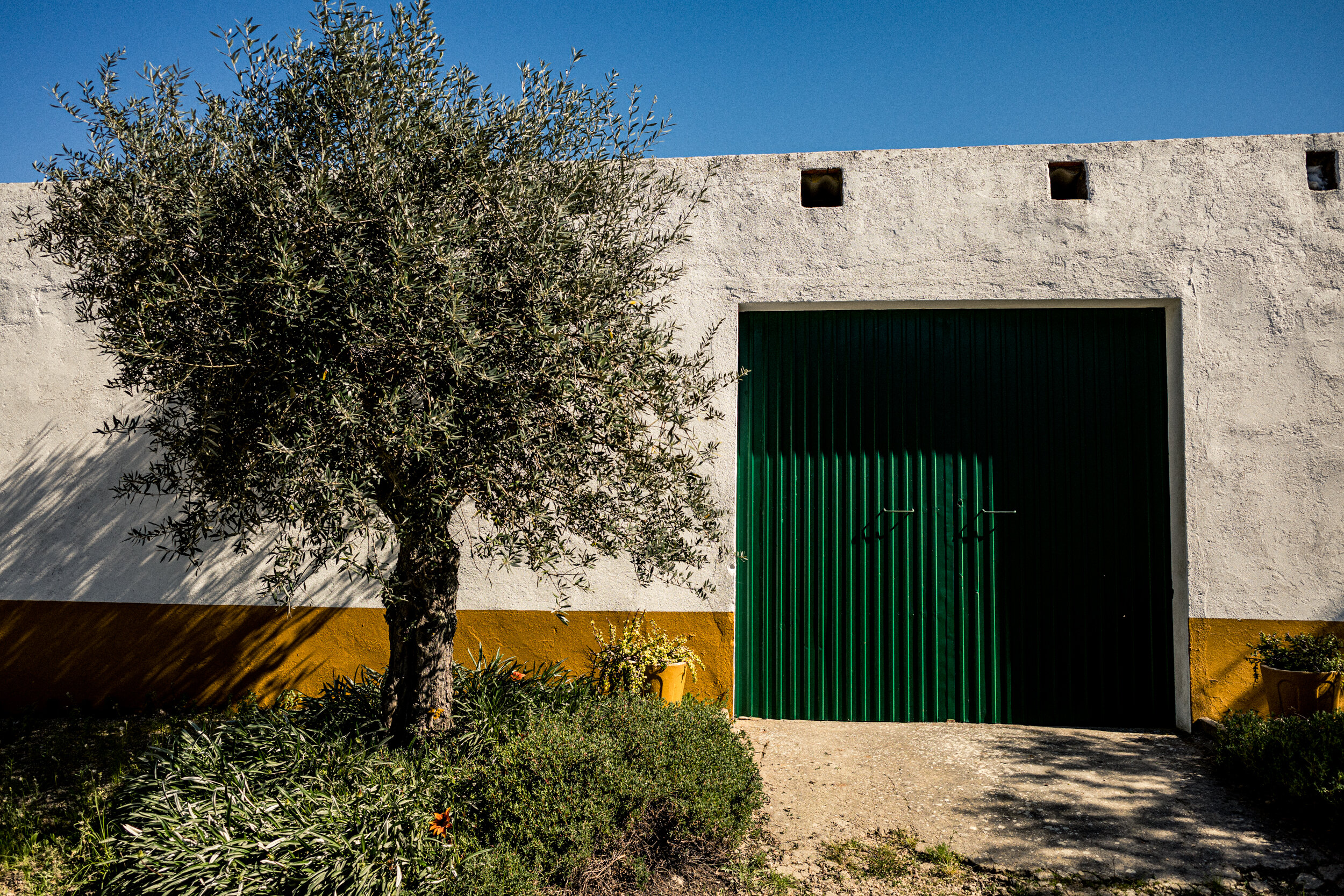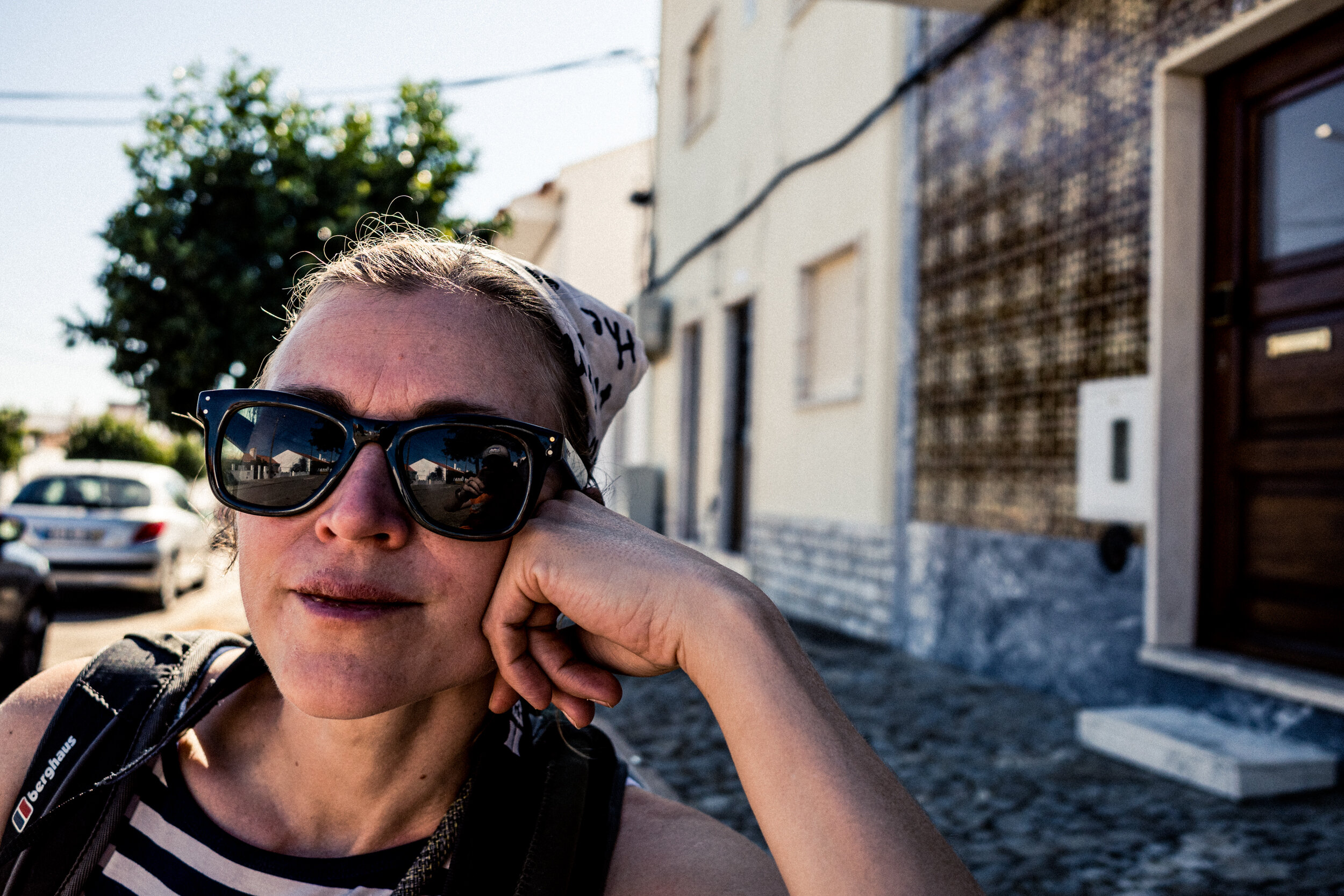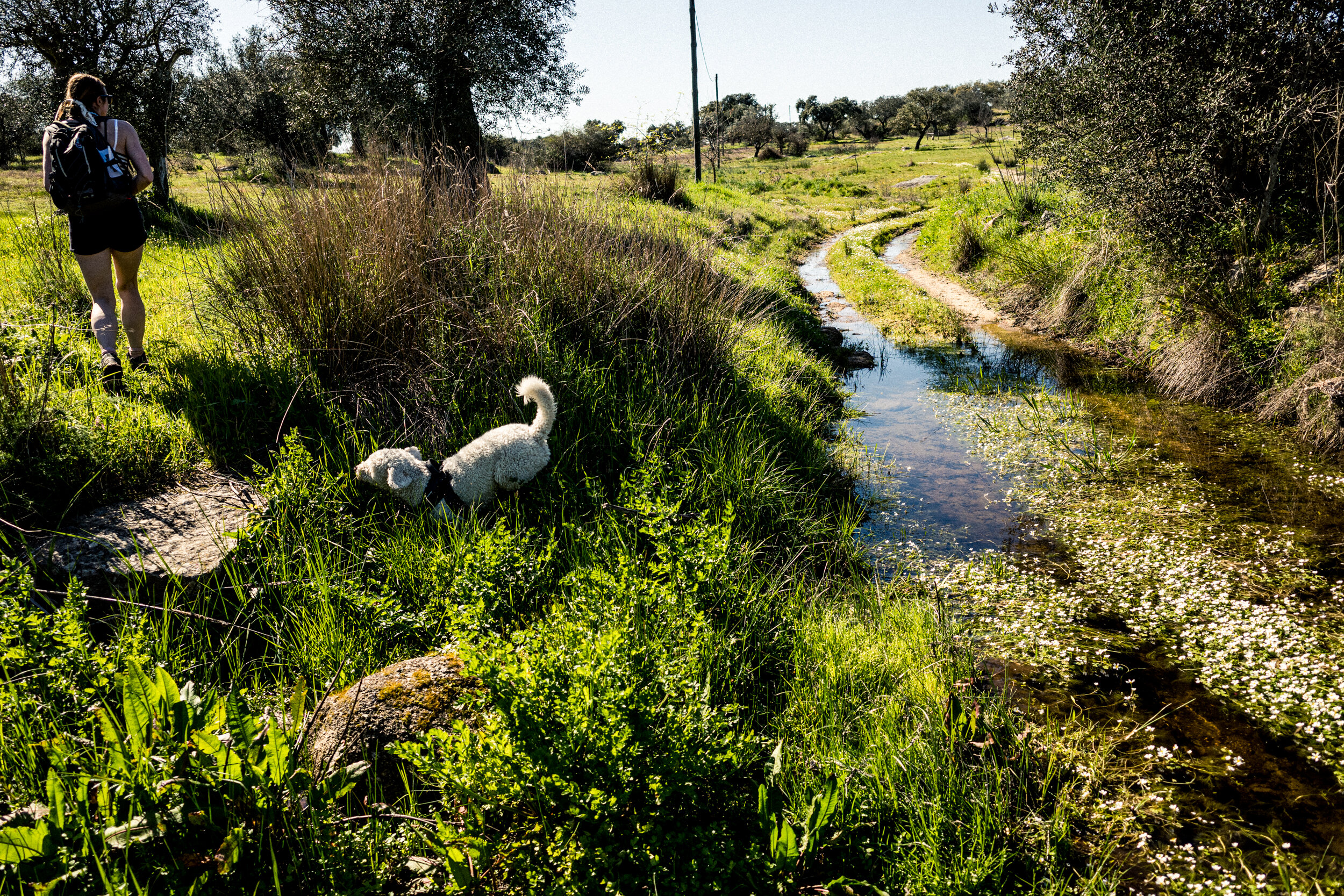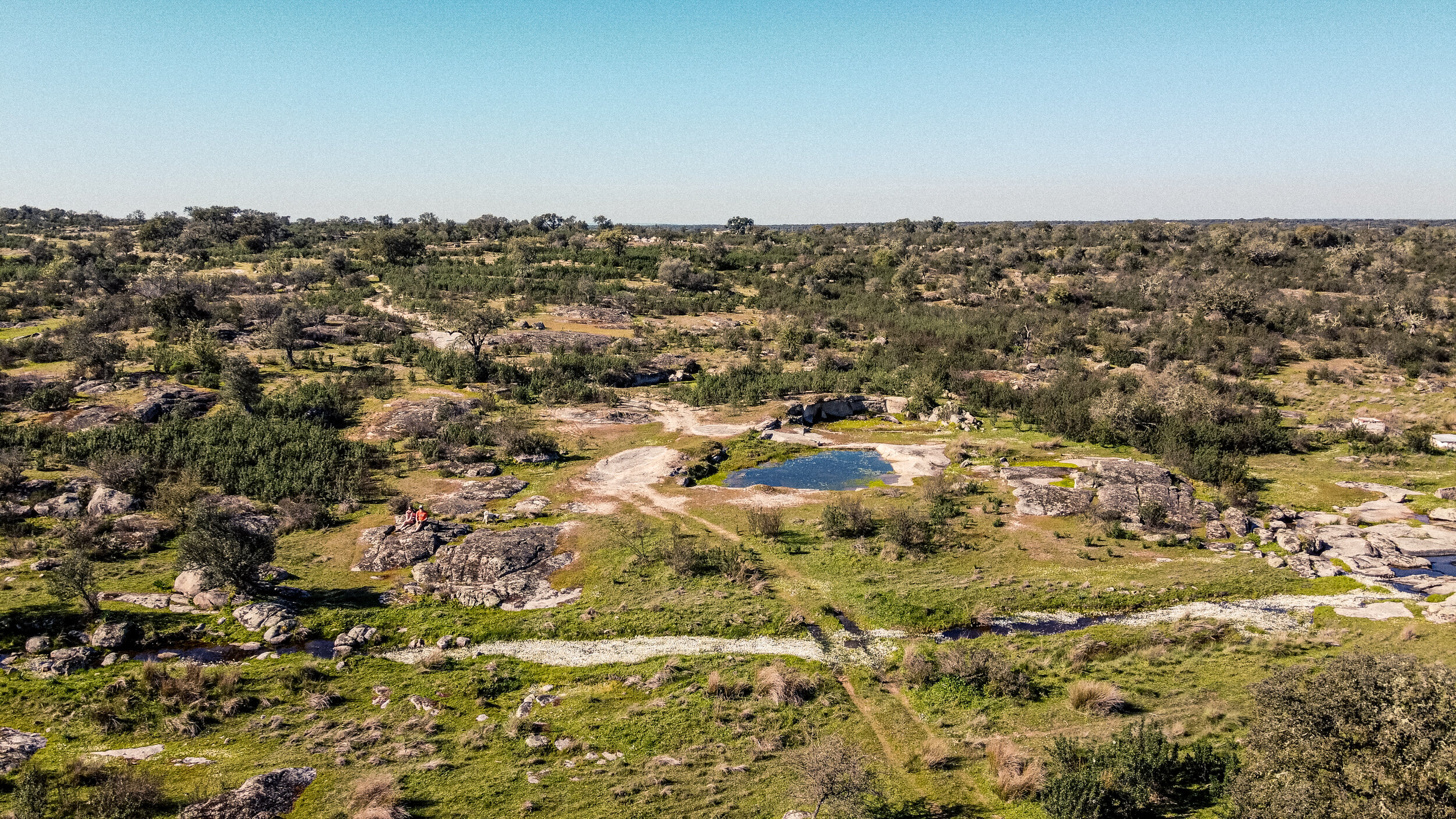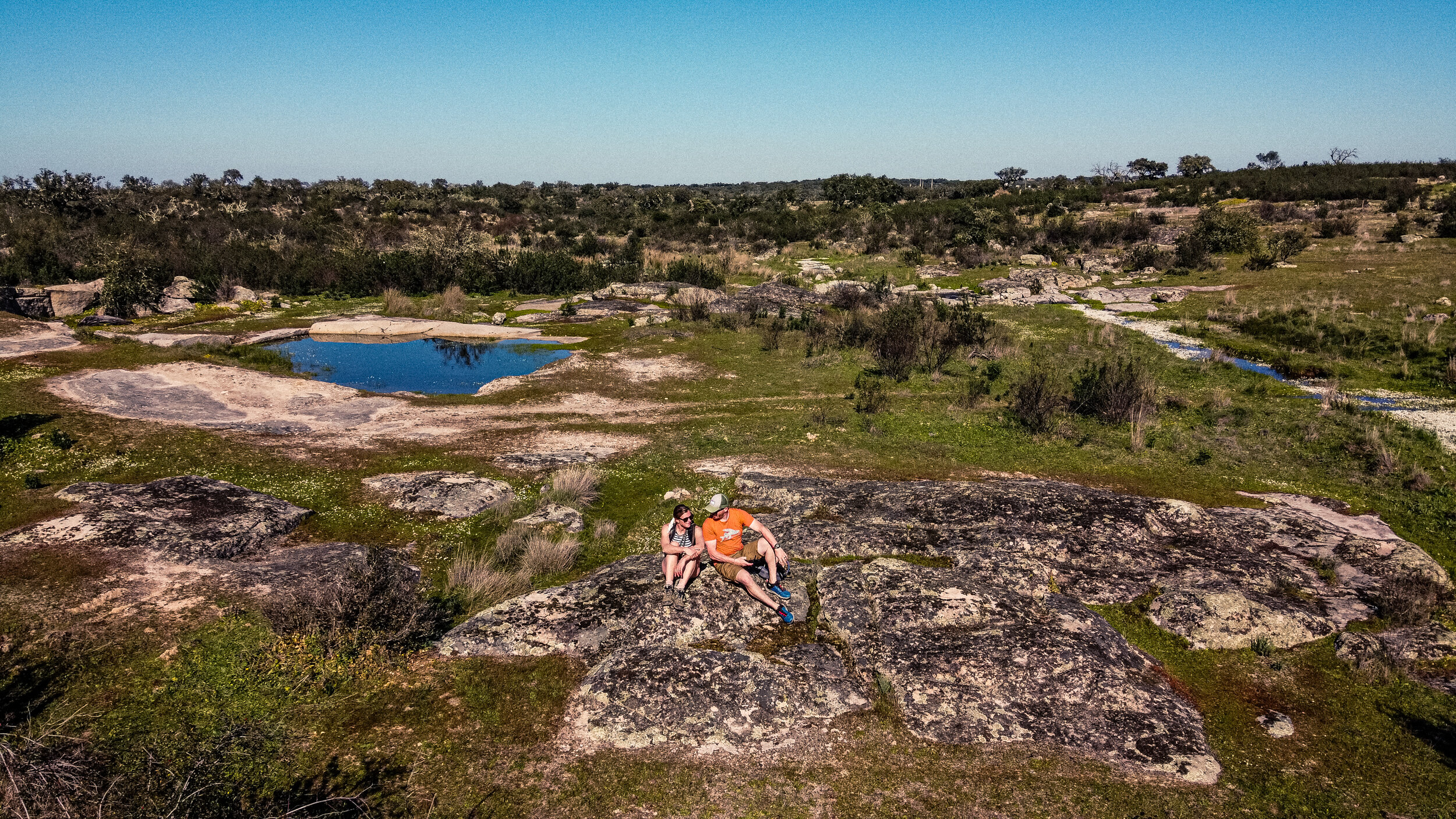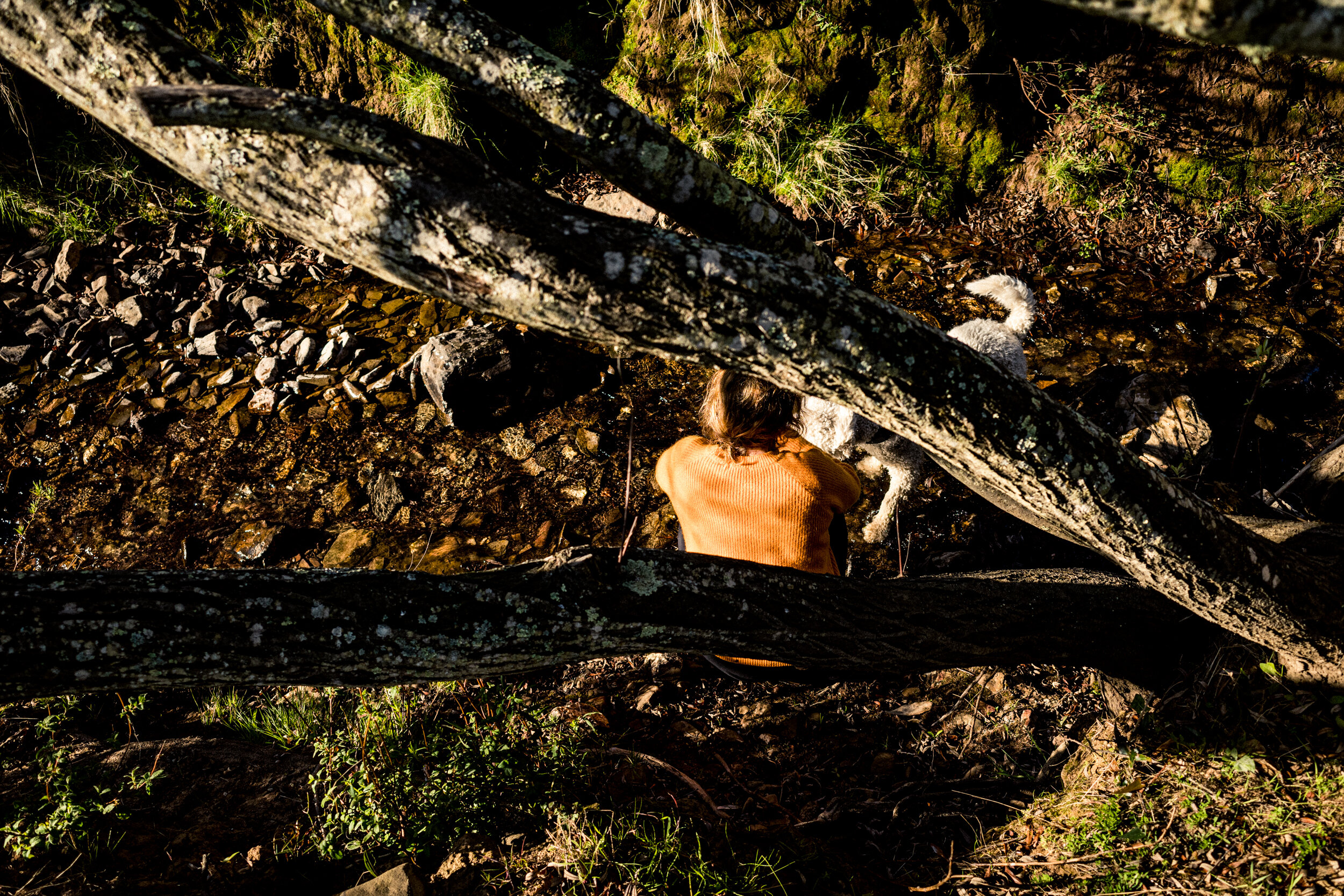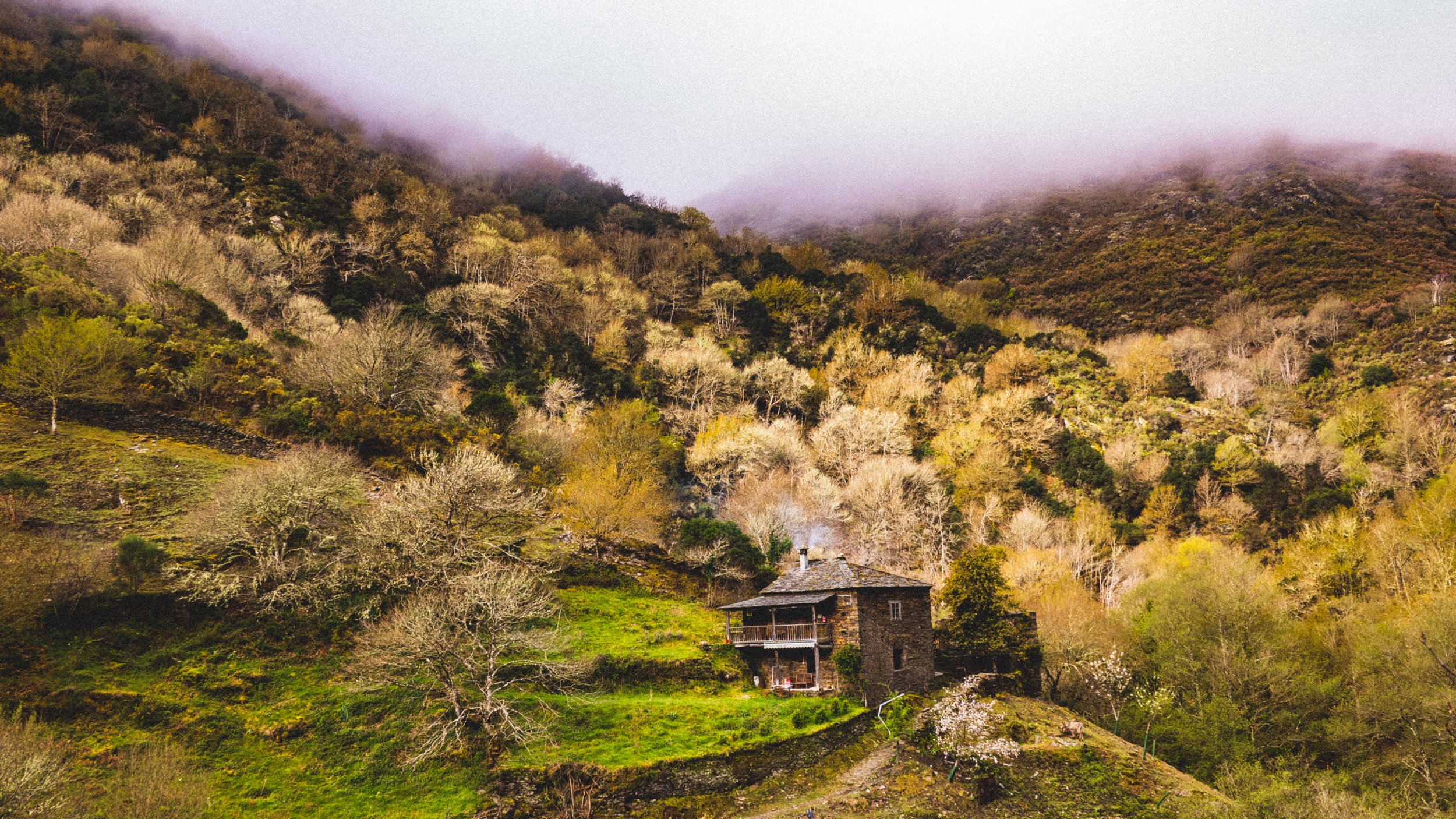Portugal: summer in winter
Portugal: summer in winter
The two of us wanted to head to Scotland, this winter. But once again, Scotland turned out to be our unicorn: beautiful, but unattainable. Which, to be honest, is slightly exaggerated. We only had twelve days to travel, and when we go to Scotland, we want the maximum amount of time to roam around and explore. So it made sense to pick up the trail where we left last year: Northern Portugal. And a look at the weather and temperature maps made us more hyped for the South than we would’ve been for the rainy North-West of Europe. In Portugal, nightly temperatures would still drop below zero, but during the day there’d be plenty of sun and temperatures between ten and twenty degrees Celsius.
Decision made!
Next to the fact we would travel without our children, this would also be the first long trip with our off-road trailer. Liene wouldn’t let the kids skip school, and travelling to Portugal and back during the seven days of spring break would be too crazy. With a little help of our parents, we managed to plan twelve days of roaming and exploring.
Using the off-road trailer was a decision we took in order to grant ourselves more freedom during our travels. Up until then, the rooftop tent on our car – once we had it set up – forced us to stick around wherever we landed, at least when we wanted to use the car. This sometimes resulted in displeasure, because we couldn’t fully explore the beautiful regions we found ourselves in. Now, we could leave the trailer at a camping site and hop in the car to head for a national park where we could go hiking for a day, visit a village, and so on!
The trailer gave us an enormous amount of freedom.
However, the disadvantage of a trailer is its mobility – or the lack thereof. You’re travelling bigger and unwieldy, which makes it harder to drive the adventurous routes to your next destination. But nothing is ever too hard, and I still had to learn how to maneuver that colossus behind us anyway: the total length of our ride was now eleven meters. Luckily, the off-road trailer can take a beating, and we didn’t really have to skip on mountain passes and dirt roads. Only backing up and turning the thing around on a mountain pass, got my adrenalin pumping. But time and experience will only make this easier.
The road to Salamanca
Without any preparation, on an early morning, we hopped in the car and left. Our first destination was located a bit passed the city of Bordeaux, about 900 kilometers from home. I like to cover as much distance as possible in the first few days. That way, when we reach the country we’re heading for, we can travel at a slower pace. The short stop at an AirBnB had its charms, even though there was no electricity in the morning, and we had to make coffee on our gas stove outside.
We pointed our compass to Salamanca, where we still had to look for a camping site to spend the night. That would be another 900 kilometers, but once we reached Bilbao and headed further into the country, those would be 900 beautiful kilometers to be grateful for. Spain’s mainland is basically a plateau featuring endless fields and forests. No dense forests like we know, but fields full of trees, always about 15 meters apart. A stunning view! Travelling further South, the landscape grew even more beautiful.
At about 20 kilometers from Salamanca, we found a camping site which somewhat answered to our demands. A typical camping site for short transits with few facilities, which kept away the big mobile homes and caravans. Simply clean showers and toilets, and already a bit of a nice view. However, the site was located next to a highway. This brought along some noise, with which we would be able to cope, since we were just there for the night.
Apart from ourselves, there were some old people wandering around, living their second life in their own camper. One of them was a Brit who could only talk about alcohol, beer, drinking, and the price of beer. He smelled like alcohol all the time… A kind man, but someone who left a bitter aftertaste. Which was proven when he came out of the restaurant with a bottle of pastis – and a breath reeking of the aforementioned liquor – and told me his wife was a nag… That kinda guy!
All other people at the camping site were kind people, passing through, each looking for their own piece of happiness and joy. Just like us! All of them were retired, which made me believe – or rather conclude – that we’re already doing what other people can only do once they’re retired. #doingwell
And before you think we act like an old couple: old people don’t sleep in a tent when it’s minus two degrees outside. The next morning, everything was frozen and as crispy as the biscuit on an ice cream. We showered in the cold, made a cup of coffee, watched the sunrise, and embarked on our journey in the best of moods. If we made it through all of this, the Southern part of our trip couldn’t be any worse.
Anyway, we were heading for Portugal again. Passed Salamanca, the plains gently faded away into a wavy landscape of hills. Once we reached the Portuguese-Spanish border, the scenery drastically changed. The differences were noticeable every meter, just like when you cross the border between Belgium and The Netherlands. We immediately left the big roads behind us and decided to travel the last 300 kilometers using nothing but little roads. A plan we stuck to for about 150 kilometers. : - )
The fatigue of working for the past weeks hadn’t left my body yet, and travelling little country roads with a trailer demands a certain level of concentration. Giving ourselves a break, we covered the last 100 kilometers driving the highway.
Bubulcus & Bolotas
Bubulcus & Bolotas was our next destination. A natural camping site in the center of the Alentejo region. Liene found this amazing spot, thanks to her keen eye for peace, nature, and simplicity. Every time we’re giving up hope of finding a spot like this, she manages to magically discover a piece of paradise!
As far as camping in the wild goes, we’re quite flexible. These are situations where you’re on your own anyways, and you can only trust on your own supplies. But camping sites still have to answer to our high demands. Or more specifically, a list of facilities we don’t want around a camping spot. Our most important wish is to have an experience as close to camping in the wild as possible, as quiet as possible. Sites with pools, playing grounds, restaurants,… don’t make it to our list. In the meantime, we also learned how to read between the lines when we’re looking for camping sites online. During our past trips, we’ve encountered a lot of sites, but we never saw a place like Bubulcus & Bolotas. There is no camping site where you’ll get as close to wild camping as you’ll do here.
It was a rather limited camping site, featuring only ten spots where to park a car or van. All other places were reserved exclusively for tents, and could only be reached by foot. There was just one sanitary facility, hidden in the bushes. Which meant we had a 360-degree view of nothing but bushes, trees, and fields. I was sold immediately.
On top of all that, since it was still winter, the place was quiet. There were only two other campers: a Dutch woman and her dog, and a Frenchman making nature reports. The fact the Dutch woman had a dog might seem like an inconspicuous detail, but not to us. We might’ve left our kids at home, but we did have our favorite canine friend, Roover, with us. Apparently, he was ready to conquer heated females. After only two hours, we found the two dogs, stuck to each other. Which happens to dogs after they had intercourse. This is called the “tie”, and lasts about fifteen minutes. Especially since this wasn’t a one-time hook-up, we’re fairly sure Roover’s encounter will result into some puppies. That’s why I handed the lady my contacts and made the deal of splitting the nest. Soon, we’ll have some puppies to give away!
Something I noticed during our trips, is that a lot of camping sites abroad are managed by Dutch people. Especially the good sites, where there’s vision, ideology, and a clear sense of how to run a site. We noticed this in Sweden, Norway, France, Spain, and now in Portugal as well! This natural site was managed by a very friendly couple. He’s Dutch, she’s Portuguese, coming from Lisbon. After our first friendly chat, it became clear they’re running their site with a lot of passion and vision. This site is now on our “Must Visit Again, When In The Area” list. The only other camping site on that list is Wildlife Sweden. Our list is a seal of approval we don’t hand out easily.
Something else I was very pleased with, was our off-road trailer. It had sufficiently proven its efficiency, by now. It only took us 20 minutes to either set everything up or to get ready for the road. This pleased my inner, overly organized Niko very much. There are some minor things I want to adjust, but overall: “I’m a happy camper”. (pun intended)
Vimieiro and surroundings
After a good night’s sleep, surrounded by all kinds of natural noises and just above the freezing point, we were woken by a beautiful sunrise at about 7 a.m. Which is sleeping in, since we’re up way earlier at home. But when you’re on vacation, without children, you might as well let it all hang out. By the way: it’s easier to get up and go to bed, when you’re following the rhythm of the sun. Else you’re just sitting outside in the dark and cold. It’s more fun to get into the tent around 7 p.m. during sunset, have a chat under a woolen blanket, hug, read, look at and edit photographs, and write this very travel report. Only to get up at 6 or 7 a.m. again, at the dawn of light. Lovely!
The best advice I can give for a warm night, is an extra woolen blanket. I ordered mine from the Dutch army and it has kept me warm ever since the first night. Wool is water resistant as well… Anyway, if you’re a camper or an outdoor type, you always have to keep one with you.
So… We were fresh and clean, and in a good mood to discover our surroundings. We had been inside the car enough for the past few days, so we laced up our hiking boots and went out for a firm walk in the area. The owners of the camping site showed us a nice walking trail, which we gently embarked on. The first part took us through the rustic landscape, with some farms and little houses along the way, and especially a lot of cork oaks – low, broad trees. It felt like we were walking across one of those miniature trains’ scale models. Everything looked so perfect and green. Of course, that was because of the time of year. Right before, and long after the summer, this is one yellow and dry desert. I’m so glad we visited this place in winter, Primavera all the way!
After two hours of hiking, we arrived at Vimieiro, the closest village. Authentic Portuguese, with its colorfully painted and tiled facades, orange trees, deafening silence (apart from the little yellow birds) and amazing (Delta) coffee stalls. The streets were empty. The window shutters of the houses were closed, cars parked underneath orange or lemon trees. Occasionally we encountered chattering elder men on a bench, eyeballing these two tourists walking around in shorts and t-shirts during winter. They were still wearing coats, woolen sweaters, even scarfs and beanies. The fact my face was as red as can be, after our hike, proves I’m a wiser dresser than those Portuguese. ; - )
We drank a coffee somewhere – 1,60 euro for two cups. If there’s anywhere in the world where they know how to brew damn good coffee, it’s in Portugal. The old man who sold us the coffee, even felt so concerned about our dog, he let him drink four glasses of water out of his hand. A sympathetic guy, for sure. I couldn’t understand a word of what he said, though.
Vimieiro was the furthest point of our hike, and we set off on the second part, back to our tent. This part of the hike was breathtaking. The same perfect landscape with those low, shadowy trees, the big rocks at the feet of every cork oak, and rock bottoms with water pools and lilies everywhere. Soft, green moss ground, looking a lot like the substrate we saw in Sweden. Just the vegetation grew lower, a bit different, and less dense. And the space we had. No house or road to see for miles. Just us, nature, and a barely visible walking trail. I lost a piece of my heart there. The feeling that would happen again during this trip, started to grow. We really took our time to experience and memorize these places and the landscape. Beautiful!
We arrived back to the camping site around 4 p.m. After chatting with some people, it was time for our all-in-one morning, noon, and evening meal. We did the dishes, took a shower, and got to bed.
According to our travel schedule, we mostly eat just one time a day. Around 5 p.m., when you’re ready preparing, eating, and doing the dishes. Right before nightfall. When it’s dark out, everything goes more troublesome and slower, so we try to prevent this. Especially when nights are very cold. This way, you automatically adjust yourself to the schedule of the sun. The Circadian rhythm, it’s called.
Menhirs & dolmens
The Alentejo region is known for its menhirs, hunebeds, and stone circles. There are some very well-known sites to visit, but those are being run over by tourists. And – as you know – we aren’t looking for such crowds. Thanks to some GPS coordinates and the tip of always to look for olive trees, we set out to discover hidden beauties of menhirs and dolmens. Most of them are to be found on private property, and aren’t accessible. But locals’ tips always offer perspective.
Our first stop would be this stunning dolmen on top of a hill. We had received GPS coordinates, showing us where to park the car. From there, we had to walk towards the North-West and – most importantly – look for an olive tree. Why those olive trees, by the way? Very simple: shepherds used dolmens as a resting place, hide-out, place to sleep,… and olives were a substantial part of their diet. Chances of one olive kernel becoming a tree over the past 1.000 years, are fairly existent – to say the least.
We climbed over a fence and started walking towards the North-West, crossing different lands. We hadn’t made it halfway the first hill, when we heard a quad snore at the fence. The quad carried a farmer, waving at us! We stayed put, and were expecting a tirade from his part. The farmer drove up the hill, and stopped his quad right in front of us. The stern look on his face quickly faded, when I gestured we were looking for the dolmen. He also pointed at my truck and said we were free to explore his lands. Which sounded tempting, because that would’ve been adventurous for sure. But I gestured we would continue our hike on foot. He gave me a thumbs up, a firm handshake, a big smile, and turned around.
We went back on our way, climbing hill after hill, until we found ourselves underneath an ancient olive tree, and I got to climb a dolmen. The view on the other side of the hill was phenomenal. The origins of and use for dolmens is still a mystery, but they’re all placed at wonderous locations.
We weren’t alone, though. About two hundred curious cows crept closer – very strategically – every time we turned our backs! It took Liene and Roover some time to feel at ease.
In the meantime, I enjoyed the view from the top of the dolmen, and tried to memorize as much of this perfect picture as I could. I want to return to this place, later, in my mind. At one of those moments you feel trapped in the concrete jungle, where everything is grey and grizzled. However banal it may sound, I already considered this a highlight. We stayed here for quite some time, before very slowly heading back to the car.
Completely stoked, we went looking for the next spot. Somewhere hidden alongside a small dirt road, once again on private property. Luckily, the owner of the property was kind enough to have built his fence around this historic location. Free entrance it was.
It never stops being a weird sighting, those big rocks, erected in a structured and unnatural way. It was an idyllic spot, surrounded by trees, in the middle of the green grasslands, with yellow flowers right in the middle of the stone circle. This spot wouldn’t feel out of place in an “Asterix & Obelix” or “Suske & Wiske” comic. It turned out to be a great spot for a picnic, to enjoy a piece of Gouda cheese – which I got from a kind man during a shoot, earlier that month –, and to cut up salami in thick slices. All of this with mustard! A mixed plate, I tell you! : - D
We were always on our own. We barely crossed other people on the roads, most villages were quiet and deserted. Every now and then, we came upon a bar with two locals, having deep conversations outside the doorstep. The funny thing: once you stepped inside such a bar, it was packed with about fifteen people, nipping their coffee, eating pastry. We often found ourselves the only customers sitting outside, enjoying our coffee, and being amazed by how many people dropped by and left the bar. In such an inconspicuous place. After all, it was still winter for them. And the weekend of carnival.
For our final dolmen-stop, we decided to visit the biggest and most touristic location. A big stone circle, which – according to historians – is even older than Stonehenge. It was a big stone circle indeed, but we didn’t think much else of it. The circle lay in a big and dusty field, trampled by visitors. We walked around it twice, and headed back to our tent.
The weather was nice, with the wind occasionally blowing firm and chilly. Since chances of rain were increasing, we decided to stay an extra day at this site. A matter of finding our calm. On top of that, I felt perfectly happy at this minimalist setting. But the next morning, despite a beautifully rising sun and clear skies, the urge to go out and explore grew once more. After all, we’re not travelling this many kilometers just to stay put at one place.
We left home with the intention to explore both the main land and the coast. After spending four days in the outback, we wanted to spend our last four days at the coast. After a delicious coffee at the dawn of light and half an hour of packing, we were ready to go. We found ourselves already quite central in Portugal and our next destination – something we decided on the day before – was only a four-hour drive away. No need to hurry.
Algarve
There are some infamous locations’ names which automatically give me chills: whatever “costa del” in Spain, the Riviera in Italy, or the Algarve in Portugal. Saying those names out loud, I envision overcrowded beaches, way too hot weather, terrible food, littered streets, drunk Englishmen,… And now, here I was. Driving straight and very self-conscious towards one of these mass tourism spots. I almost felt like a kamikaze!
There were, however, some mitigating circumstances. First of all, it was winter. It probably wouldn’t be too crowded. And our basecamp was up in the mountains, more into the outback.
The green landscape passed us by, but we already got a glimpse of what this place would look like during summer: bare, dry, sandy, yellow! But for now, things still looked fresh and fruity. I believe I wouldn’t like Portugal as much during the summer, though. Especially down South.
After four hours and an equal amount of coffee breaks, we drove the last kilometers towards the camping site Liene picked along the way. A small site, with a maximum of 25 places – this couldn’t go wrong. Until we arrived. Every place was taken by a caravan or camper. And these are things we don’t want to find ourselves surrounded by. I find that to be a terrible view, and the atmosphere and coziness at such places, isn’t any better. After taking a stroll around the site, I was already heading back to the car, not at all looking forward to the idea of driving and looking for another site.
Liene, however, proved herself smarter than me and explained to the owners of the site that this wasn’t what we were looking for, and asked if they would recommend a more suitable camping site. Somewhere we’d be alone. This turned out to be genius idea. The owners checked out my truck, and pointed down the mountain, to a big empty lot, next to a small river. “With such a car, you should be able to get there”. My heart skipped a beat. That spot was breathtakingly beautiful, and we would have a 360-degree view on all the surrounding mountains and lands. Eureka! Like we say in Dutch: “a kiss from the teacher, and one bank further to the front, Liene”. She did it again!
Prior to this trip I had a number of very heavy work weeks, home and abroad. The mileage and camp activities also started to weigh a little so I enjoyed a day of "dolce far niente". Hang out, play board games, walk up the mountain next to us and enjoyed the view, did some afternoon napping and did some writing on this travel journey ... you know, chill.
To the Beach!
I’m going to repeat myself, but those who know, also know beaches, art cities, tourist highlights, and all related artificial fuzz, give me an instant allergic reaction. I simply hate commercial clench. But Liene really wanted to see the Algarve’s infamous beaches, and I didn’t want to take that away from her. We’d see how things would go, so we set out for Praia Benagil. Fingers crossed.
If the 40 kilometer drive was any indication at all, things didn’t look good. After only five kilometers, the picturesque villages were replaced by ever-growing commercial and dirty settlements. Water amusement parks, hotels, uncharming potteries,… You know, everything which intends to make a place artificially authentic. Even Liene got nervous, she had a bad feeling as well.
I’m not going to sugarcoat things: those beaches looked like shit. Everything looked trampled. The entertainment industry was omnipresent. No beautiful natural beaches. Every spot looked beaten down. Fences. Toilet paper everywhere.
We found a spot to park the truck, walked across barren rocks, only to arrive at a place where piles of tourists stood gaping around. From the mainland, you were able to spot a bit of the real beauty, though. Something a quick drone flight confirmed: the rocks and beaches were stunning, indeed. But to keep me there for over fifteen minutes, a miracle would’ve needed to happen. Disappointed, we quickly returned to the parking lot and left this coastline behind us.
We were taken aback to such an extent, we wanted to head back to the camping site, pack everything, and drive back into the outback. Which of course was just a startle response. After driving for half an hour, we stopped for coffee at Café André – in the direction of Aljezur – sat down, and took our time to think things over. In the meantime, I had pulled out my Garmin GPS (the Overland edition), which always contains updated routes for every region you can imagine. Including off-road trails.
Those off-road trails appealed to us, and would take us to quieter places. We decided to follow a local road up to the National Park of Costa Vicentina, at the West coast, some 100 kilometers from where we were at the Southern seaboard. Driving South was a big mistake for people who – like me – suffer from megalomaniacal allergies.
Once we got to the West coast, we travelled some backroads until we bumped into a perfect little beach where only a couple of locals and a lost Frenchmen were relaxing. The day was saved! It was a great place to stay: lazing around in the sun, taking a dip in the ice cold sea,… Being able to swim in the Atlantic on February 28th, and wading back out of it like a stoned penguin, is not bad at all.
And Liene discovered her inner child. Looking for rocks and shells for our daughters at home. Playing with the dog. Screaming when running into the water, because it was too cold and nice at the same time. The day and the dream were saved. Everybody happy, dog included!
A massive detour to our basecamp brought us back to the mainland. As we drove further outback, the landscape grew prettier, more pure, and more authentic again. Just like the villages and people. What a relief. We stopped for groceries along the way. Our Keto food supply was running low. We bought fresh meat, eggs, and some nuts, so we were able to make it until we arrived back home.
Overall, the Algarve is crumbling because of tourism. Millions of tourists want to get as close as possible to the coastline, and have all luxuries right at hand. However, water supplies are low in this region. For example: the camping site we stayed at, had to recycle and upcycle its waste water to use it for maintenance, to water the plants,… The drinking water came from a well, 120 meters deep. This water had to be purified because of the high amount of iron and manganese it contained. Everything is rationed, even during winter. The future looks bleak… This regions thrives off tourism, but at a cost. I complain a lot about places and regions like these, but I’m also happy our lifestyle and way of travelling isn’t for just anyone. Because that wouldn’t be fun for me anymore ; - )
The next day, we wanted to go for a long hike, since it was our last full day in Portugal. The day after, we’d slowly head North, back home. But the owner of the camping site got on my nerves, and one particular event that morning made me decide to pack our stuff and leave early. I was grateful to the man because of the beautiful camping spot he had given us, but as soon as he opened his mouth, I cringed. He had a stick up his buttcvand was as flexible as concrete block.
Half an hour later, we were driving towards our next destination. On top of all that, it had started to rain. First gently, then it started pouring. Good thing we went on the road again. After some research, and mostly by looking at the weather charts, we drove West to eventually turn 90 degrees North. Back to Spain, since it wouldn’t rain across the border.
The Northern part of Portugal warmed our hearts again, seeing the beautiful landscapes we explored days before. But one of the biggest surprises of this trip, had yet to present itself. After our previous trip, I read about Extremadura: one of the least populated areas of Spain. Somewhere you feel like you’re in the Wild West. Nothing to find there, apart from – every 100 kilometers or so – small settlements with only a gas station and a bar. Endless landscapes, with once more those low, beautiful trees, herds of cattle, Jamon Iberico in its original form – black boars –, big rocks, and high mountains. Again, my heart skipped a beat. There was room to breathe here. Deep down inside, I promised myself to fully explore this area in the future. Probably next year, sometime around winter.
Right now, temperatures were pleasurable during the day, and cold at night. During summer, temperatures can reach 40 degrees Celsius here.
The camping site we were heading for, looked promising. The site was located in a huge, protected nature reserve. However, in reality we found ourselves amidst a bunch of elderly, in some sort of degraded Planckendael Zoo. Not our cup of tea. We went to bed early, only to leave as soon as we could in the morning. I had heard enough farts of the man sleeping in the tent next to us… Could’ve been a woman too. Anyway, he or she farted terribly loud.
The weather hadn’t gotten any better, so we shifted up a gear and crossed the Spanish mainland. The vast and stunning plateau in this mainland is breathtaking. You’re able to spot birds of prey all the time (hawks! eagles!), as well as storks (which we saw a lot in Portugal too). And driving up North, the views are phenomenal. You only learn about a country when you’re able to cross it at a lower pace. We learn a lot about the countries we visit by roaming around, slow and steady.
We closed off this delightful trip with one last stop, at the Spanish border, just above San Sebastian. It was a heavenly trip, although it was a short one. We were only gone for 14 days, but due to the intensity and diversity, it felt a lot longer. I was more than satisfied. The off-road trailer had proven its worth, it turned out to be very complementary to our way of travelling. We were even more flexible, without having to pass on the adventurous routes.
Another important realization was that this way of travelling isn’t just a phase. It’s a long-term lifestyle, coming from the need to breathe. The fact we took on those freezing nights with a smile, got up at 6 a.m. to watch the sunrise – even when it’s still freezing cold outside – means a lot. This trip confirms the fact we’re not only tied to beautiful, soft summers. We can leave at any point during the year, in any direction, to find nature and peace. And that is quite the reassurance.
Also, this brings along a ton of perspectives. Especially those where nature and authenticity are key. During out trips, we often visit tourist highlights, recommended by travel guides. Described as phenomenal experiences. We always return disappointed, realizing we let another experience slip. Those tourist highlights turned out to be true horror stories for us, in Portugal and Spain as well. We came to the conclusion we prefer travelling deep into the mainland, or high up in the mountains. Alone or with like-minded souls. In nature. This realization probably lived in the back of our heads for quite some time. But after this trip, we dared to speak our mind and confirmed what we already knew.
I also enjoyed spending alone-time with Liene. Ever since we got kids, this was only the second trip we went on for a longer period of time. I believe we are responsible for our kids, and there’s no need to ask other people to watch them, every time we want some alone-time. I also love spending time with the four of us. Especially when we’re travelling like we do, it’s great to be together.
Liene and I had a rough year, and we made some drastic and sentient choices to live differently and better. To live life our own way. We decide how we want to live and how things are done! It was a delight to notice how all these decisions became clear during this trip, just between the two of us. Every moment felt like a confirmation of the way we want to go in life. I often feel like I’m going against the flow on my own. Or at least like I’m sitting on a rock in the river, looking around and wondering why everyone else just goes with that flow – because it’s easy or they don’t know any better. This trip gave me the feeling I’m not swimming against the stream on my own. Liene and I are sitting on that rock together. We’re deciding when we’re going to float along, or when we’ll go against the flow. Together. I never felt this consciously connected before! And I feel we’re going through life stronger and more self-conscious.
That is the reason we travel like we do. To get out of our own context, to see the world from a different perspective, and – most of all – to live out of our comfort zone. The life off-road! This is how we grow, like individuals and like a family. Always closer towards each other.









